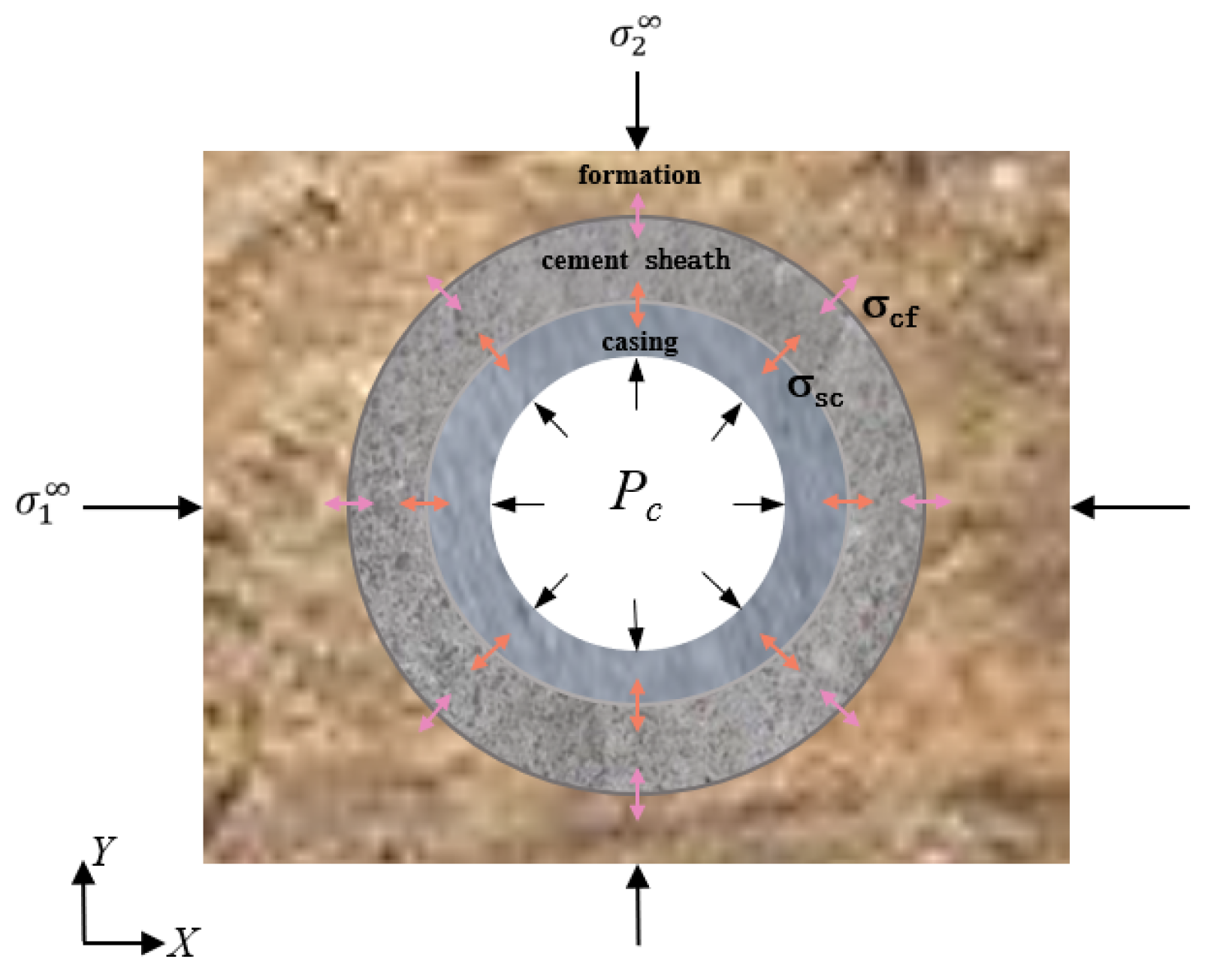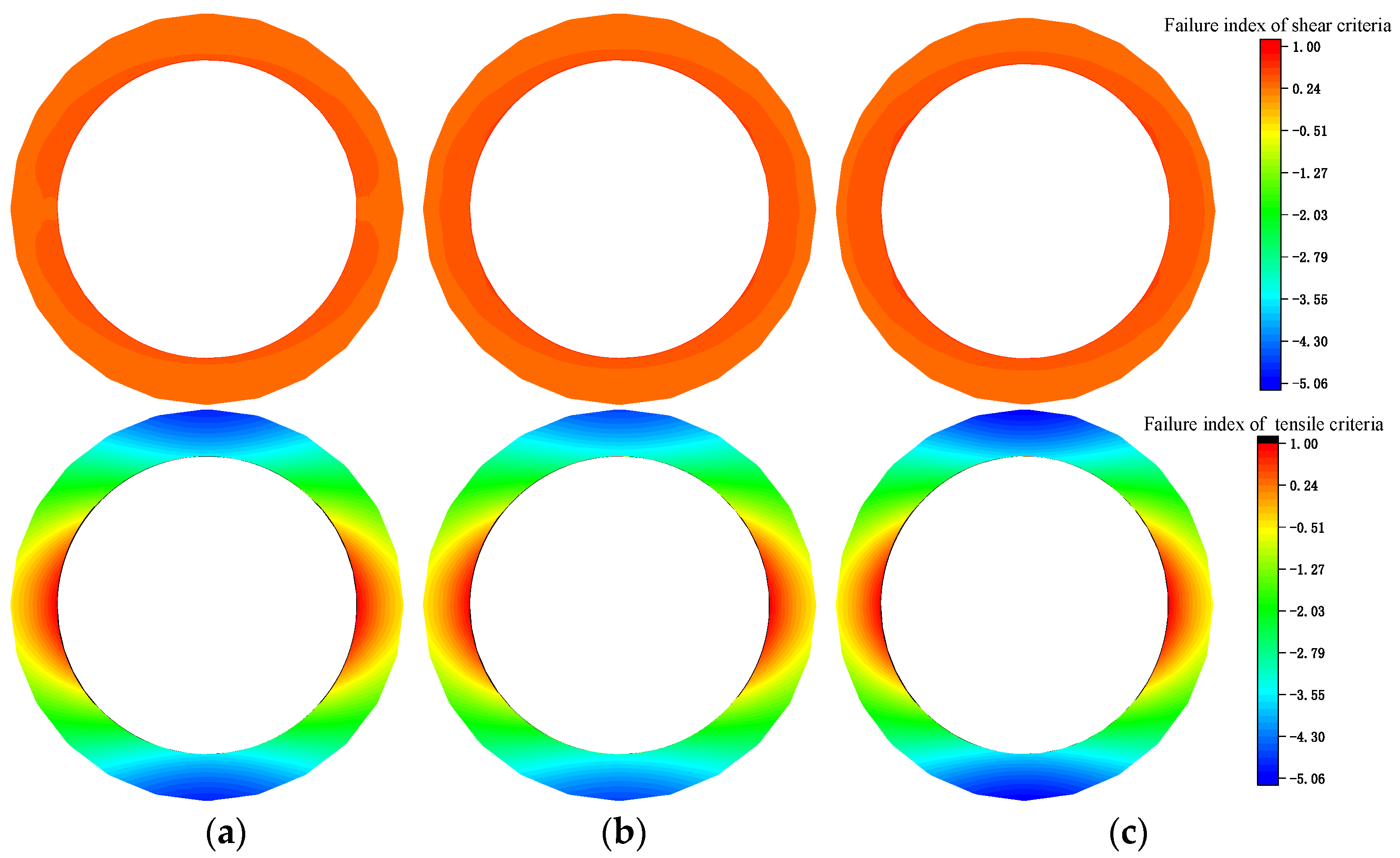Wellbore Integrity Analysis of a Deviated Well Section of a CO2 Sequestration Well under Anisotropic Geostress
Abstract
1. Introduction
2. Analytical Modeling
2.1. Calculation of Cement Sheath Stress
2.2. Establishment of Failure Criteria
3. Instance Validation
4. Results and Discussion
4.1. Effect of Young’s Modulus
4.2. Effect of Poisson’s Ratio
4.3. Effect of Tensile Strength
5. Conclusions
- The cement sheath in the reservoir section of this work area underwent tensile damage first. The cement sheath may have undergone shear damage during high casing pressure levels. The cement sheath damage criterion of such injection wells is controlled by tensile damage. It is worth noting that the tensile failure of the cement sheath does not occur first in all working conditions. The order of failure will change with different working conditions, such as different formation and cement mechanical parameters and wellbore frames.
- The Young’s modulus and tensile strength of the cement sheath are the main factors affecting the critical bottom-hole injection pressure. Poisson’s ratio has a smaller effect. An increase in the Young’s modulus, Poisson’s ratio, and tensile strength of the cement sheath will increase the critical bottom-hole injection pressure. The Young’s modulus for cement is recommended to be between 20 and 40 GPa. Poisson’s ratio is recommended to be between 0.15 and 0.25.
- The deeper the reservoir section, the greater the critical bottom-hole injection pressure.
Author Contributions
Funding
Data Availability Statement
Conflicts of Interest
References
- Zhang, Z.; Tang, Y.; Wu, Z. Exergy analysis based on CO2 capture and selective exhaust gas recirculation in a natural gas combined cycle power plant. J. South China Norm. Univ. Nat. Sci. Ed. 2023, 55, 1–8. [Google Scholar] [CrossRef]
- Vafaie, A.; Cama, J.; Soler, J.M.; Kivi, I.R.; Vilarrasa, V. Chemo-hydro-mechanical effects of CO2 injection on reservoir and seal rocks: A review on laboratory experiments. Renew. Sustain. Energy Rev. 2023, 178, 113270. [Google Scholar] [CrossRef]
- Chaparro, M.C.; Klose, T.; Hirsch, A.; Schilling, F.; Butscher, C.; Blum, P. Modelling of wellbore cement alteration due to CO2-rich brine interaction in a large-scale autoclave experiment. Int. J. Greenh. Gas Control 2021, 110, 103428. [Google Scholar] [CrossRef]
- Zhang, Z.; Bai, M.; Chen, Q. Influencing factors of corrosion behavior of carbon dioxide storage wellbore. Corros. Prot. 2021, 42, 54–57+61. [Google Scholar] [CrossRef]
- Zhang, J.; Xu, M.; Zhu, J.; Wang, G.; Ma, S. Corrosion of oilwell cement by carbon dioxide. J. Chin. Ceram. Soc. 2007, 12, 1651–1656. [Google Scholar] [CrossRef]
- Guan, J.; Liao, H.; Lin, Z.; Xie, S.; Zhao, X. Test device for evaluating cement sheath seal integrity under cyclic loading. China Pet. Mach. 2021, 45, 48–53. [Google Scholar] [CrossRef]
- Shi, Y.; Guan, Z.; Xi, C.; Miao, Z.; Fu, C. An analytical method for the calculation of allowable internal casing pressure based on the cement sheath integrity analysis. Nat. Gas Ind. 2017, 37, 89–93. [Google Scholar] [CrossRef]
- Connell, L.; Down, D.; Lu, M.; Hay, D.; Heryanto, D. An investigation into the integrity of wellbore cement in CO2 storage wells: Core flooding experiments and simulations. Int. J. Greenh. Gas Control 2015, 37, 424–440. [Google Scholar] [CrossRef]
- Lorek, A.; Labus, M.; Bujok, P. Wellbore cement degradation in contact zone with formation rock. Environ. Earth Sci. 2016, 75, 499. [Google Scholar] [CrossRef]
- Wu, Z.; Yue, J.; Li, Q.; Cao, Y.; Geng, Y.; Liu, S. Experimental study on the hydraulic seal integrity evaluation of casing-cement sheath bonding interface. China Offshore Oil Gas 2018, 30, 129–134. [Google Scholar]
- Ai, C.; Li, J.; Li, Z.; Zhang, Z.; Chen, D. Research on cement sheath stress integrity of CO2 buried well in the process of injection. Sci. Technol. Eng. 2013, 13, 2057–2061. [Google Scholar] [CrossRef]
- Yan, T.; Li, Y.; Li, J.; Feng, F.; Bai, M. The study on cement sheath sealing effect and its performance parameters of CO2 buried well. China Sci. Technol. Eng. 2014, 14, 25–29. [Google Scholar] [CrossRef]
- Song, L.; Tan, Y. A two-dimensional model analysis of casing-cement-strata in geological storage of CO2. Chin. J. Appl. Mech. 2015, 32, 288–293+356. [Google Scholar]
- Zheng, D. Geological Analysis and Cement Composition for Improving Zonal Isolation. Ph.D. Thesis, The University of Tulsa, Tulsa, OK, USA, 2023. [Google Scholar]
- Zheng, D.; Ozbayoglu, E.; Baldino, S.; Miska, S.; Liu, Y. The influence of casing eccentricity on zonal isolation. In Proceedings of the ARMA 23241 at the 57th US Rock Mechanics/Geomechanics Symposium, Atlanta, GA, USA, 25–28 June 2023. [Google Scholar]
- Zheng, D.; Miska, Z.; Ozbayoglu, E.; Zhang, Y. The influence of elliptical-geometry wellbore on zonal isolation. In Proceedings of the Paper Presented at the 56th U.S. Rock Mechanics/Geomechanics Symposium, Santa Fe, NM, USA, 26 June 2022. [Google Scholar] [CrossRef]
- Zheng, D.; Turhan, C.; Wang, N.; Ashok, P.; van Oort, E. Prioritizing wells for repurposing or permanent abandonment based on generalized well integrity risk analysis. In Proceedings of the SPE/IADC Drilling Conference and Exhibition, Galveston, TX, USA, 27 February 2024; p. D021S018R001. [Google Scholar]
- Zheng, D.; Miska, S.; Ozbayoglu, E. The influence of formation creeping on wellbore integrity. In Proceedings of the Paper presented at the SPE 2021 Symposium Compilation, Virtual, 26 November 2021. [Google Scholar] [CrossRef]
- Zheng, D.; Ozbayoglu, E.; Miska, S.; Liu, Y. Cement sheath fatigue failure prediction by ANN-based model. In Proceedings of the Paper Presented at the Offshore Technology Conference, Houston, TX, USA, 2–5 May 2022. [Google Scholar] [CrossRef]
- Zheng, D.; Ozbayoglu, E.; Miska, S.; Liu, Y. Cement sheath fatigue failure prediction by support vector machine based model. In Proceedings of the Paper Presented at the SPE Eastern Regional Meeting, Wheeling, WV, USA, 18–20 October 2022. [Google Scholar] [CrossRef]
- Chen, X.; Zheng, D.; Wu, X.; Li, C. A review of three common concrete multiaxial strength criteria from 2010 to 2020. Arch. Computat. Methods Eng. 2023, 30, 811–829. [Google Scholar] [CrossRef]
- Zhou, L.; Upchurch, E.R.; Liu, Y.; Anfinsen, B.; Hashemian, Y.; Zhao, G. Evaluating subsea capping stack usage for CO2 blowouts. In Proceedings of the Paper Presented at the Offshore Technology Conference, Houston, TX, USA, 6–9 May 2024. [Google Scholar] [CrossRef]
- Gao, D.; Dou, H.; Dong, X. Research progress in wellbore cement sheath integrity under conditions of CO2 injection and storage. J. Yan’an Univ. Nat. Sci. Ed. 2022, 41, 1–9+17. [Google Scholar]
- Li, Q.; Jing, M. Thermo-poroelastic coupling analysis of rock damage around wellbore due to CO2 injection. Chin. J. Rock Mech. Eng. 2013, 32, 2205–2213. [Google Scholar]
- Wang, D.; Li, J.; Liu, P.; Liu, X.; Lian, W.; Lu, Z. Simulation study of sealing integrity in abandoned wells within CO2 sequestration block. Drill. Fluid Complet. Fluid 2023, 40, 384–390. [Google Scholar] [CrossRef]
- Li, B.; Guo, B.; Li, H.; Shi, Y. An analytical solution to simulate the effect of cement/formation stiffness on well integrity evaluation in carbon sequestration projects. J. Nat. Gas Sci. Eng. 2015, 27, 1092–1099. [Google Scholar] [CrossRef]
- Zhang, G.; Cheng, Q.; Zhang, L.; Liu, W.; Zhao, Y.; Wu, H.; Shen, C. Calculation of 3D reservoir rock mechanical parameters of metamorphic rock reservoirs in the Bozhong 19-6 gas field of the Bohai Bay Basin and their significance. Earth Sci. 2018. [Google Scholar]
- Zhao, T.; Wang, F.; Peng, J.; Wang, B. Influence of CO2 injection on phase behavior of oil and gas reservoirs and analysis of gas condensate reservoir genesis: A case study of BZ19-6 gas condensate reservoir. China Offshore Oil Gas 2023, 35, 24–34. [Google Scholar] [CrossRef]
- Yang, X.; Liu, C.; Wang, F.; Li, G.; Feng, D.; Yang, T.; He, Z.; Su, J. Distribution and origin of overpressure in the Paleogene Dongying Formation in the southwestern sub-sag, Bozhong Sag, Bohai Bay Basin. Oil Gas Geol. 2024, 45, 96–112. [Google Scholar]
- Li, X.; Qin, R. Method of fracture characterization and productivity prediction of 19-6 buried-hill fractured reservoirs, Bohai Bay Basin. Earth Sci. 2023, 48, 475–487. [Google Scholar]







| Type | Measured Depth/m | Inclination Angle/° | Vertical Depth/m | Bottom Hole Displacement/m | Target Horizon |
|---|---|---|---|---|---|
| CO2 injection well | 4037.94 | 56 | 2600 | 2704.37 | Guantao formation |
| Type | Outer Diameter /mm | Wall Thickness /mm |
|---|---|---|
| Conductor | 609.60 | 11.13 |
| Surface casing | 339.73 | 8.38 |
| Intermediate casing | 244.48 | 7.92 |
| Production casing | 177.80 | 5.87 |
| Tubing | 101.60 | 5.74 |
| Type | Young’s Modulus/GPa | Poisson Ratio | Tensile Strength /MPa | Internal Frictional Angle/° | Cohesion /MPa |
|---|---|---|---|---|---|
| Cement | 11 | 0.12 | 2.49 | 31.67 | 9.16 |
| Cap rock shale | 40 | 0.15 | — | — | — |
| Reservoir sandstone | 23 | 0.29 | — | — | — |
Disclaimer/Publisher’s Note: The statements, opinions and data contained in all publications are solely those of the individual author(s) and contributor(s) and not of MDPI and/or the editor(s). MDPI and/or the editor(s) disclaim responsibility for any injury to people or property resulting from any ideas, methods, instructions or products referred to in the content. |
© 2024 by the authors. Licensee MDPI, Basel, Switzerland. This article is an open access article distributed under the terms and conditions of the Creative Commons Attribution (CC BY) license (https://creativecommons.org/licenses/by/4.0/).
Share and Cite
Wang, X.; Jia, S.; Gao, S.; Zhao, L.; Qi, X.; He, H. Wellbore Integrity Analysis of a Deviated Well Section of a CO2 Sequestration Well under Anisotropic Geostress. Energies 2024, 17, 3290. https://doi.org/10.3390/en17133290
Wang X, Jia S, Gao S, Zhao L, Qi X, He H. Wellbore Integrity Analysis of a Deviated Well Section of a CO2 Sequestration Well under Anisotropic Geostress. Energies. 2024; 17(13):3290. https://doi.org/10.3390/en17133290
Chicago/Turabian StyleWang, Xiabin, Shanpo Jia, Shaobo Gao, Long Zhao, Xianyin Qi, and Haijun He. 2024. "Wellbore Integrity Analysis of a Deviated Well Section of a CO2 Sequestration Well under Anisotropic Geostress" Energies 17, no. 13: 3290. https://doi.org/10.3390/en17133290
APA StyleWang, X., Jia, S., Gao, S., Zhao, L., Qi, X., & He, H. (2024). Wellbore Integrity Analysis of a Deviated Well Section of a CO2 Sequestration Well under Anisotropic Geostress. Energies, 17(13), 3290. https://doi.org/10.3390/en17133290






